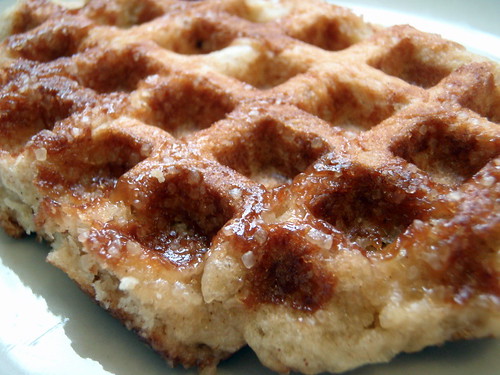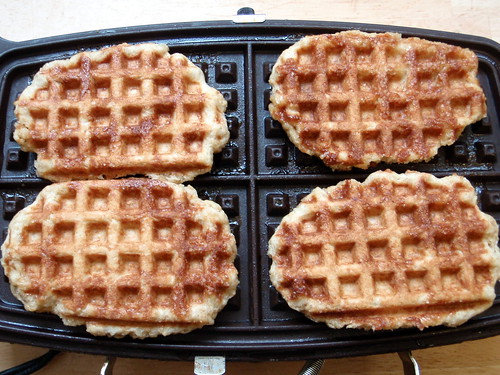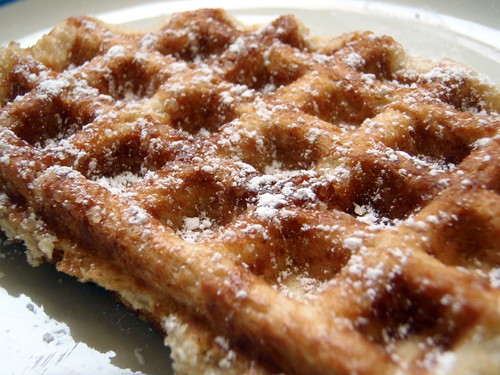I really was excited to find a recipe for a real Belgium waffle that used turbinado sugar instead of pearl sugar since it's ever so much easier to find turbinado sugar in Boston. I didn't have any bread flour so I used regular all-purpose flour instead. I can't tell you how much of a difference it made, but I definitely did end up with a dough more than a batter at the end. The post mentions that any waffle iron should work as long as "the pockets are fairly deep". I'm not sure my waffle iron falls into that category, but I didn't notice any uncooked portions so don't let that deter you. Lastly, the recipe calls for the use of a stand mixer. I don't have a stand mixer. I'd love a stand mixer. I will gladly accept a stand mixer. But until then, I have a hand mixer, and that's what I used. Since the recipe did mention that the dough would be quite stiff, I switched out the usual beaters I use for batters and used the special beaters that the manufacturers stated would work better for stiff doughs. It worked, but I can definitely see why a stand mixer (or an extra hand) would have been ideal.
Gaufres de Liege (from Chichi on The Kitchn)
makes 12 small waffles
makes 12 small waffles
6 tablespoons warm milk (no hotter than 110°F)
1/2 teaspoons granulated sugar
2 teaspoons instant yeast
1 1/2 cups (230 grams) bread flour, sifted (all-purpose flour seemed to work fine for me)
1 teaspoons cinnamon
2 teaspoons vanilla extract
1/2 teaspoons salt
1 medium egg
1 egg yolk
1/2 cup (4 oz) unsalted butter, at slightly cooler than room temperature
140 grams turbinado sugar, or pearl sugar if you choose
Cooking spray
1/2 teaspoons granulated sugar
2 teaspoons instant yeast
1 1/2 cups (230 grams) bread flour, sifted (all-purpose flour seemed to work fine for me)
1 teaspoons cinnamon
2 teaspoons vanilla extract
1/2 teaspoons salt
1 medium egg
1 egg yolk
1/2 cup (4 oz) unsalted butter, at slightly cooler than room temperature
140 grams turbinado sugar, or pearl sugar if you choose
Cooking spray
Dissolve the sugar in the warm milk; then add the yeast. Make sure that the milk is not too hot, lest it kill the yeast instead of promoting its growth. Place a plate or some kind of cover on top of the bowl with the milk, sugar and yeast. Set aside for about five minutes. When you check on it, the yeast should have bubbled up, looking light brown and spongy.
Meanwhile, mix the sifted bread flour with the cinnamon, vanilla extract, and salt in the bowl of a stand mixer. Pour in the yeast mixture; then add the whole egg and egg yolk. Mix on medium speed until it is fully combined. The dough will be yellow and stiff, yielding only slightly to a poke.
Cover the mixing bowl with plastic wrap and let the dough rest in a warm place for about thirty minutes.
Beat in the butter piece by piece; you do not have to wait for the prior piece to be fully incorporated before adding the next. When the dough has incorporated about half of the butter, the mixture will be like a very thick, somewhat broken-up paste. If you keep engaging the mixer on medium-high speed, the dough will eventually become a cohesive whole, looking smoother and more feeling more elastic. Scrape the sides of the bowl if needed.
Kneading very gently, incorporate the sugar crystals just enough to get them evenly distributed. Work quickly so as not to soften the buttery dough too much.
Divide the dough into a dozen equal pieces, gently forming them into balls.
Place the balls of dough on a cutting board in a warmish place for fifteen minutes or so. During the last two minutes of this resting time, preheat your waffle iron until it is very warm, but not hot.
Spray the griddles with cooking oil. Place each ball of dough in a whole square or section of the waffle iron. Like regular waffle batter, the dough will start to puff up. Cook the waffles until the surface is golden to dark brown. Be sure that the waffle iron you are using is appropriately deep, or else the interior of the waffle will not be cooked through.
Set the waffles on a cooling rack as they come out of the iron to promote a crispy exterior. Serve immediately with a sprinkling of powdered sugar.
Any leftover waffles, if they are not dark brown, can be carefully re-cooked in a toaster for approximately thirty to sixty seconds. Leftover waffles may also be kept in an airtight container between sheets of parchment paper, for up to three days.
My roommate declared these waffles better than the previous two. Personally, I think they're a whole other species of waffle so it's hard to compare. These seem more like cookies that I can eat with my hands rather than needing a plate, utensils, and maple syrup. I found that they were sweet enough (and a whole heck of a lot cleaner) to eat without the powdered sugar. The waffles didn't really seem to crisp up as much as get uniformly solid, but the turbinado sugar definitely kept its crunch and gave it a nice, fun texture.One year ago: Buckeyes








I used this recipe: http://liegewaffle.wordpress.com/liege-waffle-recipe-liege-gaufre-recette/
ReplyDeleteYou can certainly use another sugar but turbinado sugar will give you something completely different than Belgian pearl sugar, which looks more like big clumps of sugar about 1/3 the size of a sugar cube (and no, crushing a sugar cube doesn't really work because it crumbles too easily). You can find it online pretty easily. The clumps get all melty and the ones on the outside caramelize around the waffle adding to the flavor and texture.
I think you got the dough right -- it's supposed to be a dough and not a batter. In Belgium you can watch them take the dough balls and squeeze them between the irons. Your iron is definitely more shallow than is typical (the picture in the recipe I posted above is what they usually look like) but nobody said a shallow waffle can't taste good. But it may affect the texture a bit. Bread flour is heavier than AP so I would expect your waffles dough was wetter than if you had used the same volume with bread flour. These are definitely not your American breakfast waffle -- as you noticed, you eat them with your hands. It's a street food. Glad they turned out well!
Ryan
Yum! I keep seeing people do waffle posts! My waffle iron thing and I had a fight, the waffle iron won, but I think I should give it another try:)
ReplyDeleteLove it! I loved eating the Belgian waffles by hand from street vendors when I was in Belgium. One of my fondest memories from that trip. I love the way these look, sort of rough around the edges. My waffle iron is just sitting in the cabinet collecting dust - I should really consider making and freezing some!
ReplyDeleteI stayed in bruxelles back in 2004 and loved the street vendors and thier waffles. I would get 2 everyday I was there. Not a typical waffle you find here but how it is prepared in this article really explains alot about how they come out from a texture standpoint. It makes more sense now from a business standpoint to create the waffles as another form of income. I can just imagine people coming from miles around to get to these waffles.
ReplyDelete